Shop for PP&L Electricity Plan Options
Switch And Save
Pay Your Bill
Recommended PP&L Electricity Electricity Plans
The lowest PPL Electricity rate is 7.99¢ ($0.0799) per kWh. That is over 35% lower than PPL's Price to Compare of 12.95¢.
PPL Service Territory
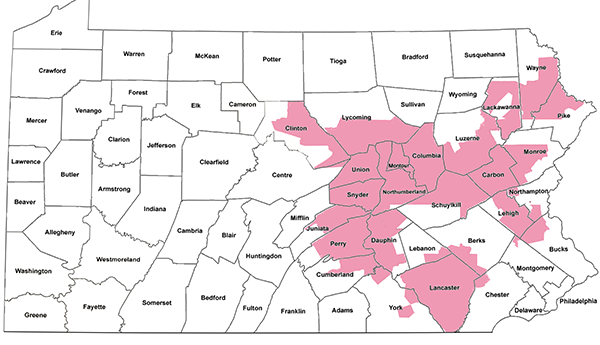
PPL distributes electricity to 1.4 million customers in some or all of these central and eastern Pennsylvania counties:
PPL serves these cities:
Compare PPL Electricity Rates
Compare alternative supplier electricity rates in the PPL service area.
- Enter zip code.
- Select "electricity".
- Choose "residential" or "business".
- Click "Shop for Rates".
In Pennsylvania, electricity utility service territories may overlap in some zip codes. If the tool reports that it has found more than one serving your zip code, don't worry! Just choose your local utility from those listed.
You'll then get to see the listing of all the energy suppliers' plans available in your area, along with rates, term lengths, and links to more detail information.
How to Start New PPL Service
Starting PPL service for your home is both easy and convenient. Just visit the PPL web site to start, stop, or move your home's electric service.
Customers can also set up service by calling PPL customer service (1-800-342-5775).
PPL will do a soft credit check to determine if a deposit is required. Be ready to supply:
- Personal Information: You will need to provide your Social Security Number or driver's license information or other valid, non-expired ID.
- Service Address: The address where you want your service turned on or switched.
- The start date for electricity service.
Usually, PPL needs 5 business days notice in advance of your start date. However, in some cases, they can provide same-day service. Call customer service to request.
Will I Need to Pay a Deposit?
Credit Rating -- PPL has the right to check your credit history and level of credit risk to determine whether a security deposit is necessary. Other factors include whether the customer was previously disconnected or has unpaid energy bills.
TIP -- Be sure to unfreeze your credit. If you have frozen your credit with any of the major credit agencies, you will need to have it temporarily unfrozen before you submit a new service request.
Pay a Deposit -- Within 3 business days, PPL must notify you in writing about their specific reasons requiring you to pay a security deposit.
PA State Laws About Utility Deposits
- Deposits cannot be greater than an estimated two months usage.
- Customers have 21 days to make a payment after the utilty sends them the deposit request notification. However, customers have three months to pay the full deposit.
- PPL can hold the deposit for 24 months. If the customer pays their bill in full and on time for 12 consecutive months, the deposit will earn interest.
- Customers have the right to use a guarantor who is a credit-worthy customer with PPL and can pay your bills if you fail to do so.
Understand PPL Delivery and Supply Charges
In Pennsylvania, residential customers pay for both the cost to deliver their electricity as well as for the amount of electricity supply that they use.
- Delivery Charges are fixed rate charges (tariffs) representing the cost of transmitting electricity to your home via PPL's power lines. The charges cover the PPL local infrastructure operating costs, maintenance, and ensures them a profit. Other usage-based charges are small costs from riders to fund projects, cover fees, etc. PPL's delivery charges must be approved by the Pennsylvania Public Utilities Commission (PAPUC). All PPL customers pay the same set Delivery rates no matter who supplies their energy.
- Supply Charges represent the price for the amount of electricity that you use. PPL customers can choose the "Price to Compare" (PTC) for their electricity supply. However, because of Pennsylvania's Energy Choice program, customers are free to also choose energy from competitive retail electricity suppliers.
Understand PPL PTC Charges
When deregulation began in Pennsylvania, all utilities that wanted to participate in consumer choice had to sell off their generators. However, the PAPUC requires these utilities to provide electricity supply at a default rate to customers in their service territory who don't shop for a retail supplier. As a result, these utilities must purchase their electricity supply for the default rate from generator companies.
The PAPUC oversees PPL's default service rates. PPL's supply rate represents generation supply costs that are passed without mark up directly through the utility onto their customers. This default supply rate is also called the "Price to Compare" or PTC.
Price to Compare (PTC)
The PTC default rate represents the actual price (generation + transmission) the utility pays for the electricity. In other words, it not only includes the generator company's price for making the electricity but also the cost to transmit it from power stations over high tension power lines to PPL's local electrical switch yards. From there, the electricity is distributed throughout the PPL local electrical grid for delivery to homes.
In Pennsylvania, PPL sets its PTC rates by holding auctions to line up their electricity supplies. Currently, auctions are held twice a year. Consequently, PPL's PTC rates change every every June 1 and Dececember 1. When the auctions are completed, the PAPUC must approve the prices for both the generation supply and transmission.
For customers, it means these electricity rates can vary seasonally; low some months, higher during others -- especially during the summer.
PPL Current PTC Residential Rate:
12.953 cents per kWh, expires 3/31/2026
NOTE: There are approximately thirty-five borough-owned public power systems in Pennsylvania. These purchase energy for their local residents. Many prohibit residents from shopping for their own provider. If you live in one of these communities, check with your local government to learn more.
How Much Do PPL PTC Charges Cost?
The DOE EIA estimates that the average Pennsylvania residence uses an average of 864 kWh each month. Therefore, an average PTC bill roughly breaks down like this:
| Rate per 864 kWh Used | Monthly Customer Charge | Total | |
|---|---|---|---|
| PPL PTC Supply Rate | 12.953 cents | 0 | $111.91 |
| Monthly Distribution Charges (excluding riders) | $0.04332 per kWh | $17.94 | $55.37 |
| Total Bill | $177.28 |
Understand Pennsylvania Energy Choice
Pennsylvania electric consumers are free to choose their own competitive retail electricity supplier. These alternative suppliers shop deals with different producers on the wholesale market to offer competitive rates. For that reason, their rates are not controlled by PAPUC the same way that utilities are. This lets retail suppliers to offer competitively priced fixed rate plans for a variety of term lengths.
Though it can seem confusing, shopping electricity plans is an easy process. The trick is finding the one that meets your needs. That's why retail energy suppliers in Pennsylvania offer two types of plans:
- Fixed Rate Plans have their price rate set for the same price over the term of the contract. Customers can count on stable energy rates on plans lasting from 6 to 36 months. However, many fixed rate plans come with early cancellation fees for breaking a contract early.
- Variable Rate Plans Don't want to be tied to an electricity plan contract for months or years? Then choose a variable plan. Variable plan rates can change from month to month depending on the price of the electricity supply. That means there's nothing to prevent your rate from going up one month or down the next. However, these plans don't have a contract or any termination fees and this allows customers the flexibility to shop for new rates and switch to better deals without paying any penalty.
Your Energy Usage and Understanding Your PPL Bill
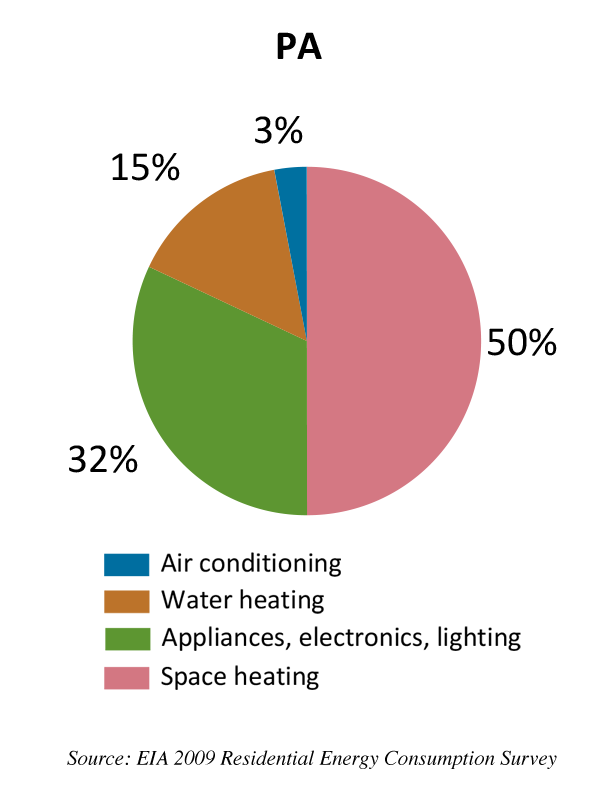
While your energy usage habits are unique to you, any Pennsylvania native will tell you that winters can be bitterly cold and summers can be hazy, humid, and hot. While most PA homes rely on natural gas for heating, roughly 1.6 million (29%) of homes in the state use electricity.
- Approximately one third (32%) of home electricity usage goes to electronics, lighting, appliances, and air conditioning.
- Pennsylvania residents spend on average 5% of their annual energy costs on air conditioning. Half of PA households have central AC.
- The remainder of energy use goes to water heating, refrigeration, lighting, electronics, clothes dryers, cooking, and small appliances.
Want to learn more about your home energy usage? PPL customers can track 24 months of their electric usage plus other relevant information on each monthly bill or by logging on to your PPL account.
The best way to cut your electricity bill is to reduce your usage:
- Seal your doors and windows against winter and summer drafts. Not only does it keep out the cold or hot air but it also reduces the amount of mold, pollen, and other allergens getting into your home.
- Add insulation to your attic, basement, and duct work.
- Install a programmable or smart thermostat. Programming it to set-back the temperature when you're away or inactive can improve your home's energy efficiency and help cut your energy bills.
Your utility company can provide a wealth of resources and offers programs to help you improve your home's energy performance.
Understand Your PPL Bill
Your PPL bill contains many details that can be confusing to customers. But there's lots of useful information to help you better understand your usage and rate. Below, we break down the most important items on a sample PPL Electric bill.
PPL Sample Bill
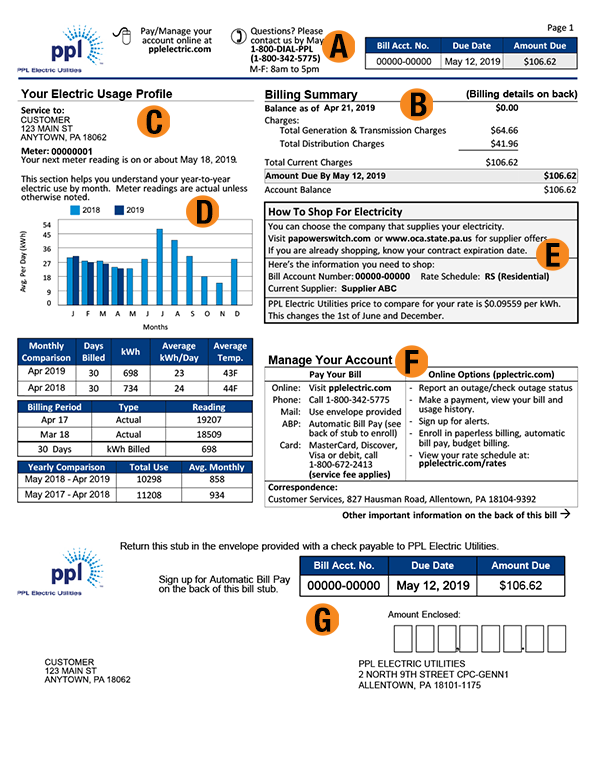
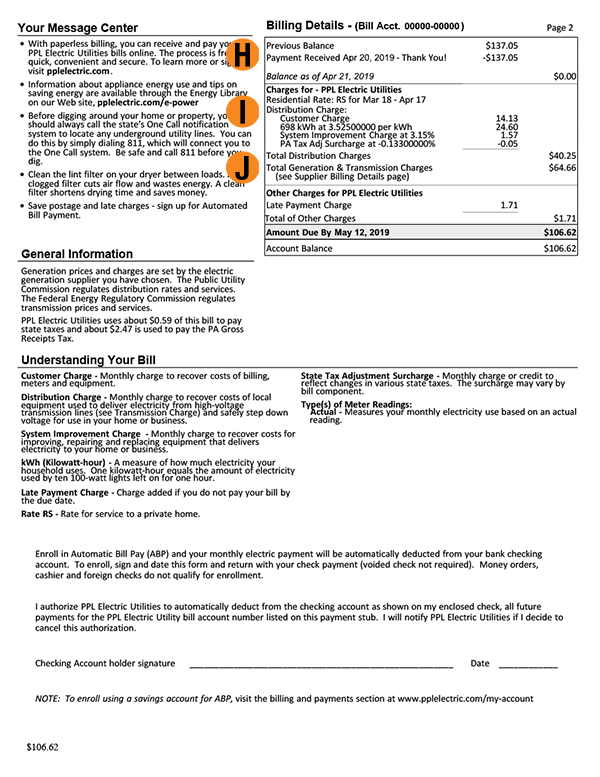
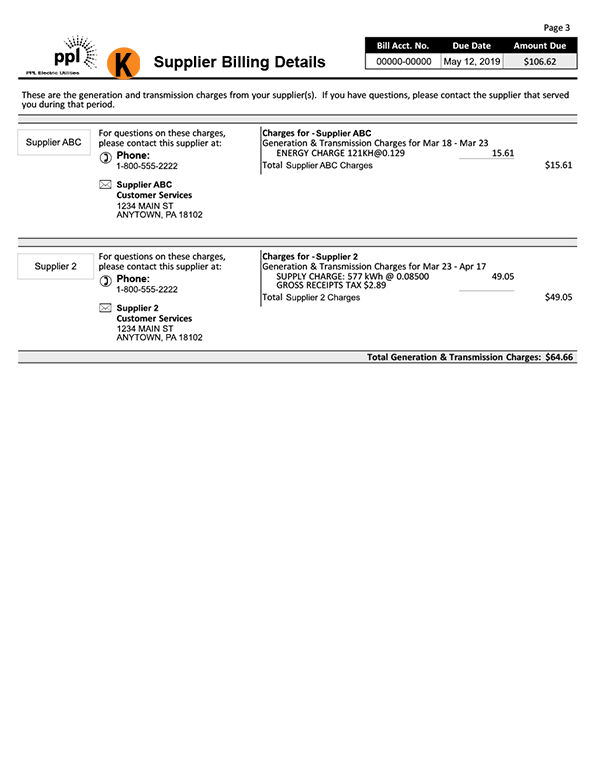
- Account Information. This includes your name, 10 digit PPL account number, the bill's due date period, and the payment amount due.
- The Billing Summary section shows an overview of account balances, current charges, date due and amount due.
- Electric Usage Profile is divided into two sections. This first part shows the service address, the meter number for that address, and the date of the next meter read.
- This section of the Electric Usage Profile shows the average daily usage over the past 24 months. It features monthly usage comparisons and average temperatures. This feature helps you gauge how well your home heats and cools.
- The Shopping Guide shows the information you'll need to provide when you select an electricity supplier: your PPL account number, the rate schedule ( RS = residential service), and PPL's current PTC rate.
- Manage Your Account shows resources to help you pay your bill and manage your account online.
- The bill stub contains important acocunt information to credit your payment to your account. Include this payment stub with your check if you mail your monthy payment to PPL.
- Page 2 shows important details about your PPL bill. These include the previous balance due and the date and amount of the payment received.
- Breaks down the charges currently due PPL. These show the amounts that make up the distribution portion of your bill.
- Details the Electricity Supply portion of your PPL bill which are composed of the generation and transmission charges. Details are spelled out on Page 3.
- Page 3 of your PPL bill contains your electricity supplier's billing details. It shows the generation and transmission charges per kWh for the billing period, any monthly charges, and taxes.
Compare PPL Rates
PPL Coupons, Energy Promotions, Discounts, Rebates and Promo Codes
As your local electric utility, PPL offers several rebate and energy efficiency programs to help customers reduce their monthly bill by upgrading their home's energy performance. Some programs also offer money-saving incentives while others could make paying your monthly bills much easier during those expensive winter months.
| Program Name | Program Type | Benefit |
|---|---|---|
| Appliance and HVAC Rebates Program | Energy Efficiency Rebate Program |
PPL customers can take advantage of rebates on the purchase of ENERGY STAR certified appliances and HVAC systems.
|
| Appliance Recycling Program | Energy Efficiency Rebate Program |
PPL customers can properly dispose of their old appliances and get paid for them.
|
| PPL OnLine Market | Energy Efficiency Rebate Program |
PPL residential customers can save on LED light bulbs, smart thermostats, dehumidifiers and more by shopping the online PPL Marketplace. Registered customers get rebates on orders of up to 10 LED lamps per category, 2 Wi-Fi Thermostats, 10 occupancy sensors, and more . |
| New Homes Program | Energy Efficiency Rebate Program |
PPL is working closely with area builders who are constructing energy-efficient homes that deliver more than just energy savings. Homes built through this program are 15% to 50% more energy efficient than new homes built to Pennsylvania's standard building code. Homes qualified through the PPL New Homes Program can qualify for special Energy Efficient Mortgages. |
| Residential In-Home Audit | Energy Efficiency Rebate Program |
PPL customers can sign up for an In-Home Audit. A certified energy auditor will:
|
| WRAP | Residential Energy Efficiency | Helps eligible PPL customers a way to reduce their electric bills through home weatherization, free energy-saving products, and conservation with a free energy audit. |
| OnTrack | Bill payment assistance |
Based on income and debt, PPL offers eligible OnTrack customers to have a portion of your debt forgiven each month as long as they pay a $5.00 co-payment and make their OnTrack payment in full and on time each month.
|
| LIHEAP Cash and Crisis Grants | Bill payment assistance | LIHEAP usually opens in early November and closes in early April. The program is available to eligible customers whose income is 150% of the Federal Poverty Level or below. |
| Operation HELP | Bill payment assistance |
Operation HELP is a one-time annual emergency financial aid to pay heating bills for families with financial hardships.
|
| Customer Assistance & Referral Evaluation Service (CARES) program | Bill payment assistance |
There are no income guidelines to qualify for the CARES Program. You may qualify for CARES if you:
|
| PPL Customer Assistance Program (CAP) | Bill payment assistance |
PPL's Customer Assistance Program (CAP) can give you a monthly credit on your PPL bill. The credit is based on your household's gross income and energy use. To apply. Customers will need to supply the following information:
|
Read PPL Reviews
Because PPL serves a large east-coast regional market segment, central and eastern Pennsylvania customers can get a better picture of how good a job it does by comparing it to similar large-scale utilities. While PPL is not accredited with the BBB, it is the top-ranked eastern utility for the tenth consecutive year in J.D. Power's 2021 utility residential customer satisfaction study. The utility also rated well in Escalent's 2021 Utility Trusted Brand & Customer Engagement™: Residential study
| PA Energy Ratings Score | Better Business Bureau | J.D. Power 2021 Electricity Utility Study | Escalent 2021 Utility Study |
|---|---|---|---|
| N/A | Not Accredited | 779of 1000 pts | 736of 1000 pts |
How Do I Get the Cheapest PPL Rate?
Shopping for a new PPL Customer Choice Plan can seem daunting at first. But, once you understand how it works, it's very easy and straightforward. To begin, you should have these three things with you when you shop for electricity.
- Your current bill. Your past usage per billing period can help you estimate a how much a plan might cost you each month.
- The current PPL PTC and expiration date. Knowing the current PPL supply price lets you compare rates offered by retail energy suppliers. This way, you can get a better feel for what suppliers are offering, for how long, and if any of their incentives make their price work for your family's need.
- Your PPL of Pennsylvania customer account number. This 10 digit number is located on your bill. Having it handy lets you sign up with a retail supplier right away.
PPL Shopping Questions
The best way for a PA energy customer to avoid making a bad choice it to ask the right questions. That way, you can learn exactly the information that can save you money. When you shop for electricity service in Pennsylvania, always be sure to ask these important questions:
- Is the rate variable or is it fixed?
- Is the rate competitive with the current PPL supply rate?
- How long does the plan contract term run?
- Does the plan's contract term last longer than PPL's PTC rate?
- Does the plan include any recurring monthly charges?
- Does the plan have an early cancellation fee?
- Does the supplier offer any customer incentives or rewards programs?
- What happens when the contract expires?
Other Commonly Asked Pennsylvania Electricity Questions:
Who bills me? PPL sends a single bill that outlines and adds up your monthly charges.
What are the Terms of Service? In PA, Customer Choice Plans must include Terms of Service that explain and identify specific charges and any fees a customer will face when they sign up for an electricity plan. Not all suppliers have the same terms. That's why all Pennsylvania energy choice customers should read and understand the terms of service and contract summary for any plan they are interested in before they sign on to the plan.
What are early termination fees? Switching retail suppliers before a contract ends can involve paying early termination fees. These can take a big chomp out of your checking account you if choose to switch retail providers before your plan contract ends.
Where can I find more information on my usage? PPL customers can 24 months of their energy usage on their monthly billing statements. This information is also available through your PPL online account.
Compare PPL Electricity Rates in Your Area
Bill Questions? Electricity Out? Contact PPL!
Having problems or interruptions with your PPL electricity? Here's the proper people to call.
PPL Billing Problems
- First thing to do is contact PPL. If you are having trouble paying your monthly bill call PPL's Customer Service: 1-800-342-5775. Have your account number ready.
- Need extra time to pay your energy bill? You can apply for a Due Date Extension by calling PPL Customer Service or by applying on-line.
- You can change your bill due date! Once every 12 months, customers can change their electric bill due date. Be patient because it takes 2 billing cycles go into effect.
The PAPUC requires all PA public utilities to offer Budget Billing. PPL Budget Billing takes your annual electricity costs and averages them out over the cost of the year. This ensures that customers aren't presented with unexpectedly high bills at peak times.
PPL Emergencies and Outages
All power lines are extremely dangerous! Never attempt to move a downed power line by yourself. Call 911 and then notifiy PPL.
- Report safety hazards involving power lines immediately to PPL at 1-800-342-5775.
- You can also report downed lines or outages at PPL's website.
- Check PPL's current electric outages as they are being repaired.
PPL Service Area Providers
| Company | Rating | Phone |
|---|---|---|
| Constellation | (4.2/5) |
866-773-8761 |
| Frontier Utilities | (3.8/5) |
866-775-9922 |
| Energy Harbor | (3.6/5) |
866-632-6308 |
| APG&E | (3.4/5) |
866-751-6415 |
| Santanna Energy Services | (3.1/5) |
866-607-2101 |
| XOOM Energy | (3/5) |
|
| Think Energy | (3/5) |
866-763-5041 |
| American Power & Gas | (2.9/5) |
866-763-3786 |
| Provision Power & Gas | (2.6/5) |
866-929-2842 |
| Direct Energy | (2.5/5) |
866-646-0311 |
| NRG Home | (2.4/5) |
|
| CleanSky Energy | (2.3/5) |
866-751-2986 |
| Major Energy | (2.1/5) |
866-756-8272 |
| Green Mountain Energy | (2.1/5) |
|
| Symmetry Energy Solutions | (2/5) |
888-549-1087 |
| National Gas & Electric | (2/5) |
|
| PAG&E | (2/5) |
|
| NextEra Energy Services | (2/5) |
855-639-8091 |
| Public Power | (1.4/5) |
866-752-4690 |
| Verde Energy | (1.2/5) |
866-953-8160 |
| Spring Power & Gas | (0/5) |
866-759-4976 |
| Indra Energy | (0/5) |
|
| 22 results | ||
Pennsylvania Zip Codes with the Cheapest Electricity Rates
The Latest PPL News
Get Creative with Energy Savings this Holiday Hey Mom! Check out these holiday no bake cookie recipes! Keep your young ones happy cutting delicious cookies while you cut your December energy... [read more]
Save Now with Cheap Priced 12 Month Plans Get the most savings on your PA electricity rates when you shop 12 month plans priced to beat Met-Ed's higher PTC rate. This year has been brutal for... [read more]
Lovely LED Lighting that Lacks Lethality Low voltage LEDs lets you use lot of strings. But is it safe? Follow our 5 tips to help you decorate your home safely with holiday lighting. A... [read more]




